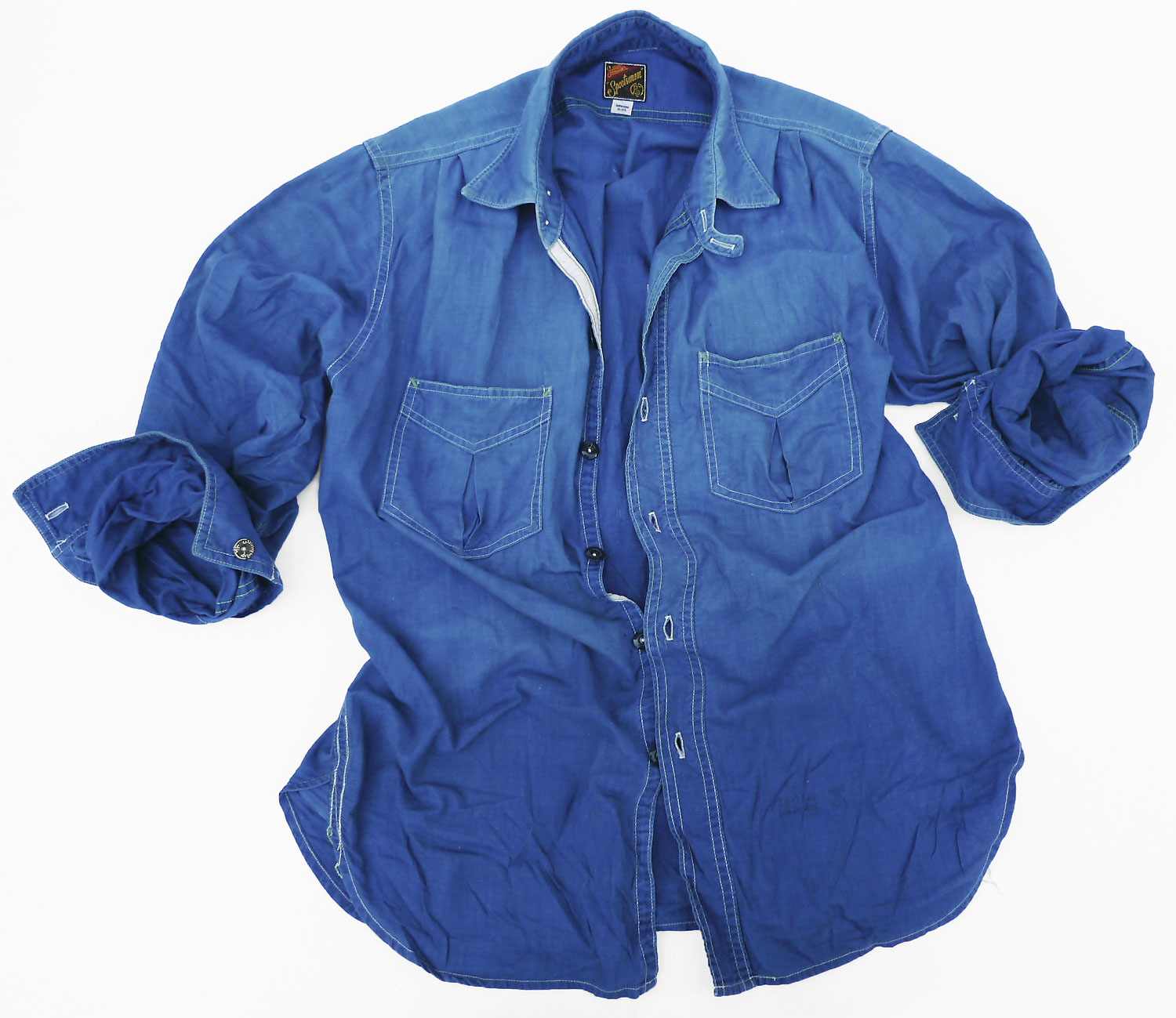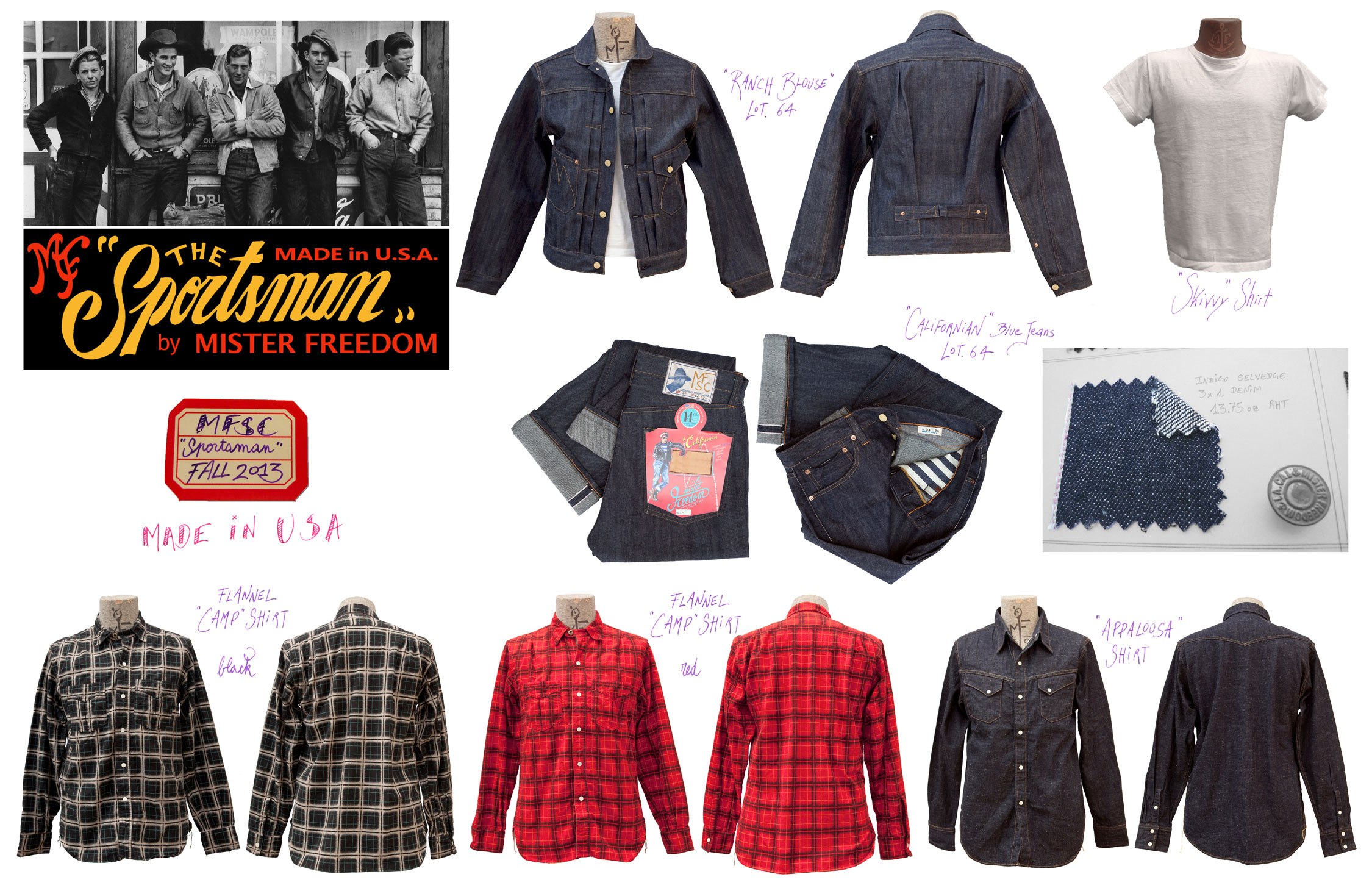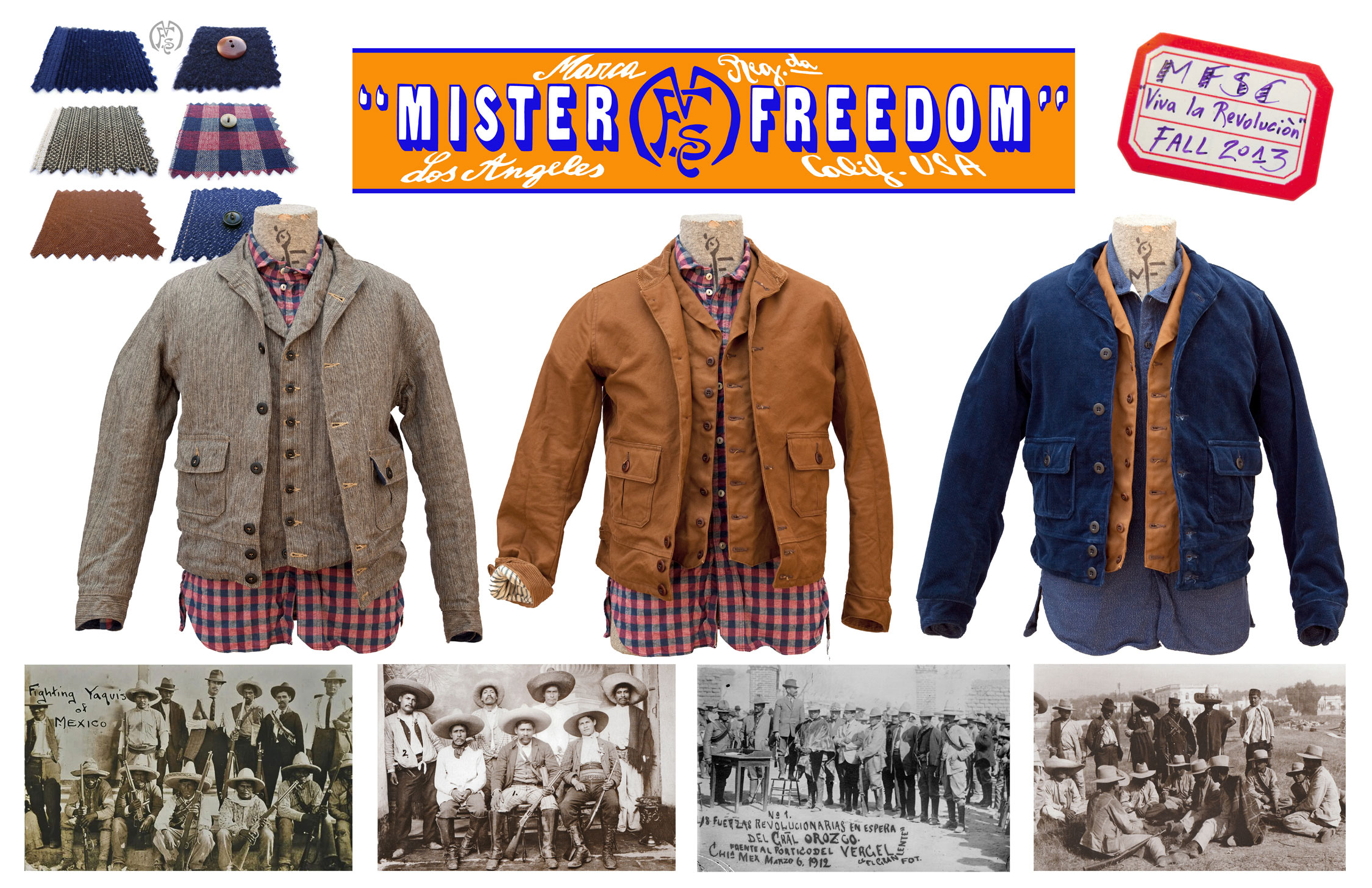-
Posts
39 -
Joined
-
Last visited
Content Type
Profiles
Forums
Events
Gallery
Store
supertorial
Classifieds
Posts posted by MisterFreedom
-
-

The problem with tucking them in, besides looking like an aging man, is that you get an uneven fade...
7 -
 Full line-up preview for the "Sportsman" Fall 2013 posted here
Full line-up preview for the "Sportsman" Fall 2013 posted here  5
5 -
 Full line up for Fall 2013 posted here
Full line up for Fall 2013 posted here  3
3 -
For those of you who use INSTAGRAM, i will be posting some photos this week on this account:
http://instagram.com/superfuture 2
2 -
Originally used to insert removable 'collar stays', to keep collar points straight. Called 'col a baleine' in french because those stays were first made of whale 'bones'.
An 'Apache' trick was to stitch razor blades on the inside of their coat collars, to prevent being grabbed by the collar in street fights.
With shirting, sticking a blade in those concealed indigo popeline bags might have been an option...
The white bias tape loops are designed to hold the scarf.
14 -
Thank you all for the mileage you put in those... Sure beats nasty industrial distressing!
And thank you for all the goodies

Those rider's will never forget you
 10
10 -
@knucks: you should join a forum where people care about what you have to say. Keep it gentleman like, or go flex out in the sand box to vent out. I believe we are all adults here.
11 -
something that involves soles and leather has been on the drafting table indeed... just having some hide sourcing issues, but we're figuring it out
4 -
christophe: i'm curious do you plan on doing a re-release of the original 7161 or atleast another waist overalls,with the many different colours of denim anytime in the future
Probably not for a while, as there are so many new things to experiment with...and so little time ;-) We still use that 'trick' (inspired by some vintage pieces that came out of crunch/war time prod, when everything at hand was sut/sewn) with some in-house products in small batches though.
0 -
@badseed, Jordan just told me! Looks like there might be fewer than six degrees of separation in this small World...
My girl actually wears quite a few of the pieces, and mixes with her own style. The sizing is what makes it work, even if the patterns are not 'adapted' to the female frame . There are just only very few XS being made, so i don't even post that option.
Maybe one day a full collection, but they'll have to make days longer than 24h first ;-)
0 -
No doubt badseed, no doubt. and THEY're coming packin' ;-)
0 -
Touché 'thor' ;-)
To be exact, I deserve the Barbour Int'l 'hall of shame'. I'd be rubbing waxed elbows with a few others there. Mea culpa
9 -
Will happily repair em babies. Contact [email protected] on how to proceed. Sorry about the monkey wrench in the tour.
Thanks to all of you for the support
0 -
To Whom it May Concern,
Have you heard about the CRRW? It's international…look it up:
Committee Regulating Right & Wrong. Awesome board of Directors, avid web thinkers and other after hours useless debaters and posters. There is yet to be an order of the day, but Mister Freedom will make sure to closely follow the guidelines of the first ruling.
Until then, dig this:
At this moment, you think 250 000 homeless Honshu survivors care more about your opinion than about the help they are getting from the American Red Cross?
You want to PC me? Really...?
You draw your lines and walk your streets tall to straighten things right and do your thing. But I have a feeling by morning you'll still be sitting in front of your little computer, typing harder than you'd hit.
Res non verba, kid. You look that up too.
And you know where to find me.
0 -




 0
0 -
-
-
...to all of you for your support and feedback.
(Sorry about my sporadic interventions, i have just gotten back form severals trips in a row.)
I was VERY impressed by all the work done on the photo shoot by Cotton Duck (the session was masterfully shot, modeled and edited, many thanks to Cotton Duck and Ordo again).
Kiya @ Selfedge has been VERY kind with his introduction of MF® to his loyal followers, and i am proud and honored that this MFSC collection is now part of his inventory, next to the big players. ( www.selfedge.com , Kiya's website is so well and tastefully done that is is a pleasure to navigate). Can't wait to visit the Selfedge store one of these days.
On a technical note, here is a little recap of the concept of the collection that was never publicized:
It is the story of a Merchant Navy sailor in the 30s/40s who cruised the South Pacific Ocean. At each Naval Base he was anchoring, he went to see the local Naval Base Tailor and had custom made garments. He'd bring his own fabric, collected during his travels, and his own specs. Being the Merchant Navy and not the US Navy, restrictions on personal effects were looser and he was able to get away with looking sharp even in work dungarees. His custom clothes mixed naval aesthetics, work practicality and period accurate detailing.
For example, his Deck Coat pattern was inspired by an original 1920's US Navy wool Pea-Jacket, but he preferred to have it made in 14.5 oz indigo denim, more suitable for his cruise weather requirements. The lining was collected during a previous tour of Europe, an original mattress cover striped ticking twill.
The utility chambray shirt had an inside passport secret pocket, a chest original slanted pocket he designed for easier access and indigo fabric facing from Japan. The chambray fabric came from an early 1900's work apron from France. (it was re-woven exactly like the sample by Toyo).
The denim Utility shirt was the osmosis of a 1930's CPO wool shirt/a uniform shirt/ and original pocketing. Some detailing influences came from British shirting makers tailoring (curved bottom flap and tucked button to keep shirt closed at all times). The metal snaps were 'borrowed' from US Army web gear production.
The denim seafaring bag original design included leather handles (from the chin straps of a USAF type B-3 flight jacket), an original horsehide leather pocket (Our sailor had a USAF aviator buddy on board and traded some tobacco for a pocket of his type A-2 leather flight jacket).
The denim Utility trousers are an absolute original design. The 'mysterious' red tape comes from a European tailoring period detail. Bottom hems were often done in that manner, to avoid the bulky aspects of fabric fold. The local tailor used available bias tape (restrictions due to troubled times), found red to match the coin zip hip pocket. You'd only roll up your pants on cleaning deck duty, to keep your breeches dry, so the colour was not supposed to show. (the bell shape of original Navy trousers actually has its origin in the 'keeping your pants dry' when mopping the deck. Comes inspection time, you'd better have ya breeches down!).
The original "denim rivets" were used/thought of because no metal rivets were available at the Tailor Shop. The waist hook is a common detail in European early work pants.
The lighter 11oz indigo denim fabric was used for comfort, again as climate requirement. These dungarees need to be really worked on to get their real 'beauty'. Once worn and sun faded, they get to another level.
The chino pants are of a 1940s US Army influence (therefore using metal US Army tin buttons). The lower rise, striped cotton ticking lining, and navy blue cotton stitching were our sailor personal custom specs.
Voila!
This script, historically plausible, was the backbone for all the original designs. Garments that never existed, but could have. Not replicas, nor 'vintage inspired with a twist', that i let other design studios tap into.
I hope this answers a few questions. Gotta run for now.
Thank you again for your support.
Cheers,
MF®
0 -
Hum...Thx Bill...
0 -
-
-
The cover of the Free & Easy April issue. They are having a "Naval Fair" at the "Rugged Museum"...No rubberLized coats, just NavaR stuff...
The 1/2 Toyo advertising for the new collection.
2/2, next to the editorial review by Chief editor Mr Onozato (I had Google translation on that, but still made as much sense as an import self assembly tool manual)
A page on USN peacoats...
A page on USN chambray shirts, still featuring McQueen in the brilliant "Sand Pebbles" movie.
(Mc Queen (to the chinese naval tailor): "I don't need whites! You makee blues, plenty blues!")
A page about the MF® store, featuring naval stuff. 1/2
2/2, for those of you french speaking, i pulled a fast one on the description of the navy knife on the bottom. "Zboub" is slang from something else...But the magazine came out April 1rst, right?
A little article in "Rolling Stone" magazine (Japan, obviously), April 2008. The mag is about a year old in Japan.
Cheers everyone, will be back asap.
Thanks a bunch,
C.
1 -
I know brother man! I can't get this thing right! Think i fixed it now...I should stick to my day job anyways...Hope ur well.
;-)
1 -
Ahoy!
I understand the concern about the price difference with Japan and US.
Here's the low down:
First of all, putting this concept together has being a huge investment, no efforts were saved to launch this line. I have been working on it closely with SC for a year and half, both companies investing time and money.
I have now the exclusive rights of distribution in US and EU for this collection (makes sense since it is MF® design, but being manufactured by SugarCane, the line could fall under their established US and EU distributors).
Technically, Japan retailers (Hinoya, Beams, Junkie Style etc...who will carry the collection) cannot export to US, as much as MF® cannot export to Japan (agreement between MF® and SC).
But short of sending Guido to break legs, i will just honor my side of the gentleman's agreement.
Anyone who wants to buy from Hinoya is welcome, and they might save money, indeed.
On a tech. note, most Japan retail stores carry "one wash", which rinses out the starch, necessary to keep your own sturdy creases in the denim...I recommend getting a raw issue and do the rinsing at home. I'll post later on how i did it for mine, which is already getting some cool sign of abuse...
Also, industrial washing with denim is the worst thing for the environement (chemicals all go in our rivers), so i always opt for raw versions.
The urging question here seems to be about the price difference in JP and US. The MF® retail prices had been calculated early on (import fees are different whether you send 1 piece as "gift" or whether a company imports a whole commercial shipment). The US products will also have extra labor involving MF® labeling, packaging etc...
Hinoya is the "Wal-Mart" of denim and it is hard for small stores to "compete" with their prices and selling strategies. Ask around to your disappearing local Mum n Pop downtown stores...They sure "made a killing" selling appliances for twice as much as the suburbs Giants, right?
Result: Travel through small town America, and you feel like Charlton Heston in the opening scene on the "Omega Man"...
I believe in local economy, so i don't buy "made in China" when i can find it (for more money) "made in US", nor do i have products manufactured by underage, underpaid kids in Malaysia. I chose "made in US" or made in places where craftmanship and labor laws apply, such as Japan...
I will get my shoes re-soled by my local cobbler as opposed to buying a new pair, "made in blabla", for the price of the re-soling job. My local cobbler is worth me saving the extra dough to give him the job.
So, at the end of the day, Mum n Pop didn't fold because of me.
But, at the end of the day, it's YOUR call.
Since all of this might sound like rambling to some, I have worked out the suggested retail price for the Peacoat in the US to $589.95
And believe me, with what my cost is for this high quality product, no one's "making a killing" here.
Trust me.
I'l be posting more interesting facts (now that the $ issue has been addressed) about specs, with photos soon, for those into it.
In the meantime, the peacoat is available here:
http://item.rakuten.co.jp/hinoya/sc11500a/
and eventually here:
(and maybe soon in the "Paul Smith" Paris/London/Tokyo stores...
Thanks for reading.
Cheers,
Christophe Loiron
Mister Freedom®
1



















MISTER FREEDOM
in superdenim
Posted
The new mf.com is now live 24/7. The store, however, only stays open from 11pm to 6pm...
Apologies for all the remaining typos, will get to them asap.
The old blog is still here.